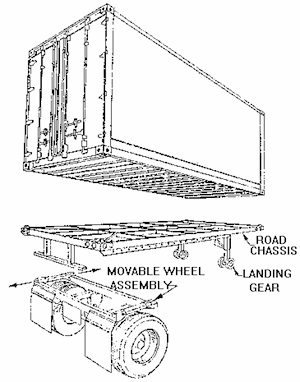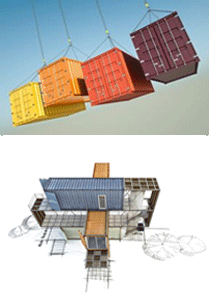- Home
- Building
- Transportation
- Dimensions
- Container Costs
- Used Containers
- 20 FOOT
- Book Store
- Container Sizes
- Companies
- Manufacturers
- Plans
- Drawings
- Used For Sale
- Projects
- Carriers
- Green House
- Benefits
- Construction
- Origins
- Design
- Specs
- Industry
- Refrigerated
- Cranes
- Open Tops
- Intermodal
- Insulated
- History
- Articles
- SCH Blog
- Contact us
- Submit your site
- Suggestions
- Privacy Policy
Intermodal Containers
Intermodal Containers can be reused for multiple purposes (transporting freight, stacking various types of cargo).
Their function & flexibility explains why there are over seventeen million such containers in the world.
Commonly called shipping containers, intermodal containers are used to move different types of goods from one location to another. Its denomination varies according to the context of shipping.
It is either called box (when transporting freight in smaller amounts) or high-cube container (the unit is taller than the usual). Anyhow, irrespective of its name, the intermodal container is manufactured in conformity with ISO1 specifications and standards.
Due to its characteristics, the intermodal container is utilized for transporting freight on long distances, being an essential element in the international trade system.
Delivering cargo inside shipping/intermodal containers is safer and more efficient than the “break bulk” type of transport (where the cargo is simply loaded in the means of transport).
This method of transport, using containers, was first employed by the United States military, and started from cubic units with an 8-foot (2.438 m) design. It developed through extension to a standard length of 10-foot (3.05 m), 20-foot (6.10 m), and 40-foot (12.19 m). Gradually, some companies started to manufacture containers of even bigger dimensions. This ensures availability for a wide range of cargoes.
As opposed to the containerization system of transportation, there is a series of methods that don't resort to containers to move freight (the goods are unpacked): bulk cargo , break bulk cargo, tankers (for liquids).
Intermodal containers are usually made of corrugated weathering steel and have doors at one end. It is cubic and the standard side is of 8 feet, 20 feet, 40 feet respectively. Depending on their size, the containers can be loaded in a column of up to seven units. Other versions have 9 feet 6 inches (2.90 m) and 10 feet 6 inches (3.20 m).
Hybrid types of containers were designed to suit the needs of different companies. One can recognize the “nationality” of an intermodal container after its custom size. For instance, a unit of 48 feet (14.63 m) or 53 feet (16.15 m) is often encountered in USA, whereas a container of 8 feet 2.4 inches (2.5 m) can be labeled as European. The latter was adapted to fit the Euro-pallets. A customized size (slightly wider than the 8-foot standard size) to fit the national type of pallets was designed in the Australian trade system too.
Swap body units are somehow similar to intermodal containers due to the common system of mounting fixings. However, they differ in the presence of folding legs, which allows them to be displaced without using a crane (as in the case of the shipping containers).
Each container has to receive an ISO 6346 code in order to be marked for identification. The reporting mark allocated consists of the following elements (they have to be used together):
- owner code, consisting of three capital letters;
- product group code, consisting of one of capital letters U, J or Z;
- six-digit registration number;
- check digit.
In order to express the capacity of a container, one uses twenty-foot equivalent units, called TEU, or its multiple, a FEU. A FEU equals 2 TEU, meaning forty-feet units.
An equivalent unit represents the measure of cargo capacity corresponding to a standard container of 20 feet (length) × 8 feet (width).
The type of cargo influences the size and design of the containers. Therefore, the standard container is adapted depending on the goods carried within. For instance, refrigerated containers are used to transport perishable goods, tanks in frame for bulk liquids, open top containers for collapsible cargoes (for instance rubbish, coals etc).
Other container types include:
- flush folding flat-rack containers (to transport heavy cargoes that cannot fit in a standard container:-e.g. Timber);
- general purpose dry vans (typically used for a load made of square, rectangular objects or other solid recipients: boxes, cases, sacks, bales etc.);
- insulated shipping container (for delicate freight that needs special protection against the elements)
- rolling floor containers for heavy and difficult to manage cargoes
- open side containers ( applicable to oversize pallet)
- platform/bolster containers;
- ventilated containers (for organic products)

Intermodal containers dimensions
